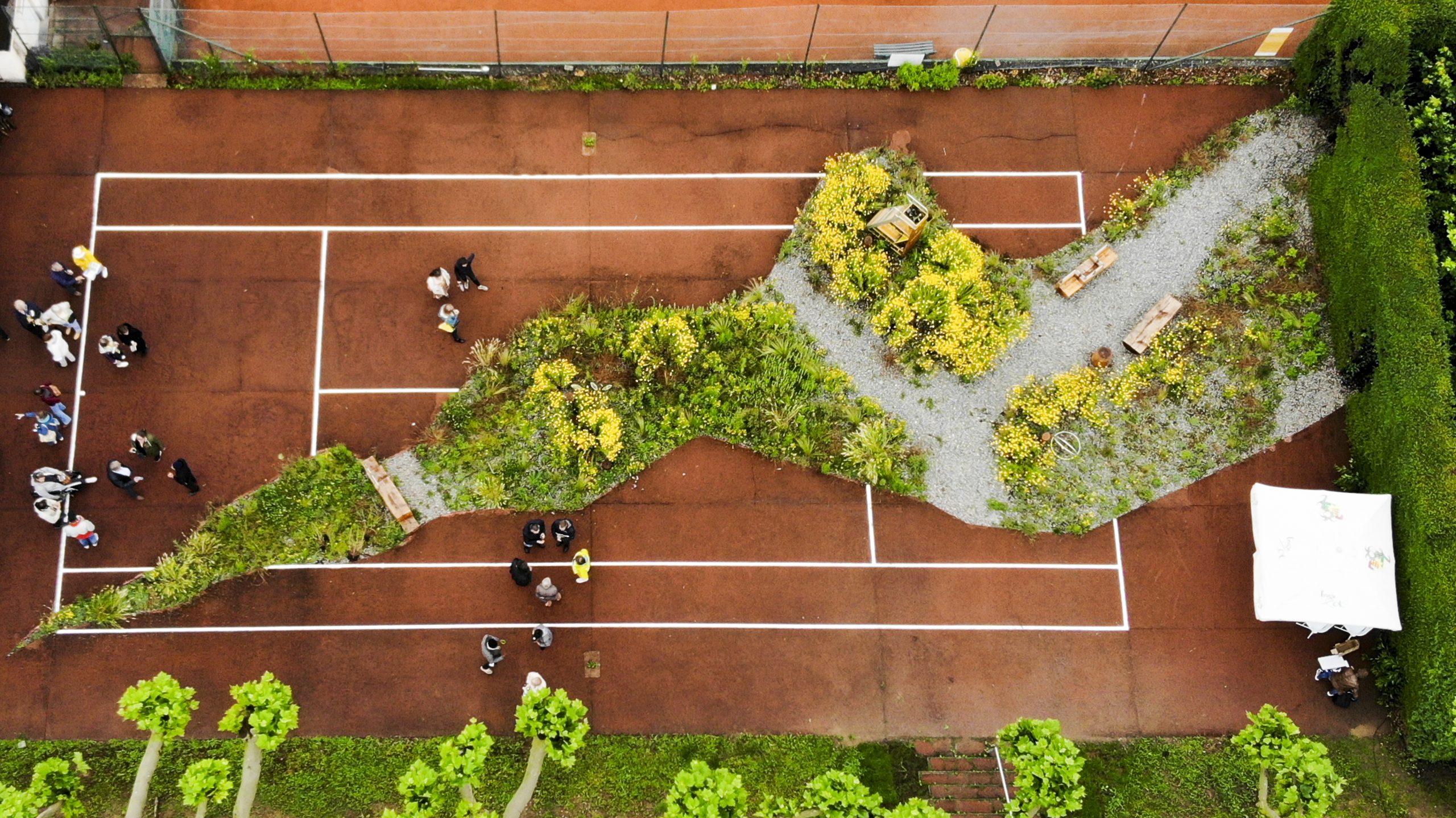
The Crack
Alive Architecture + Taktyk present us “The Crack”, a project located in Belgium that tries to reactivate a community through a complex of tennis courts.
At first glance, this project looks like any contemporary depaving design. It is relatively well-executed and delivers a bold and legible aesthetic. That is already something…More interesting is to debate the real agency of landscape.
Therefore, we didn’t choose a successful project but an attempt. The site is located in Kapelleveld in Brussels, a cooperative garden city designed by Louis van der Swaelmen, an influential landscape urbanist at the time. He had envisioned here a network of green lanes where neighbours could meet and a community centre and a park at the core of the city
The central park has never been built and become privatized by a tennis club used by expats, whereas most of the green lanes have been closed over time.

Plano original de la ciudad jardín de Kapelleveld / Original plan of garden city Kapelleveld
Ilustración / Illustration: Louis van der Swaelmen
The garden city became a place without accessible open space where three generations of inhabitants (local middle class, Italian migrants, and lately North African and East Europeans) barely co-exist, and engage with each other.
Can landscape architecture support collective endeavours, literally crack the mental and physical borders that we acknowledge between humans? Our project reclaims the central core of the site adjacent to the community centre by activating a left-over tennis plot.
Uncovering its ground brings life cycles and co-construction processes back. The “crack” points toward a hard edge that we open to connect to the valley system.Those were our initial intentions, this tactical approach advocating the creation of a garden in a garden city generated debates, conversations and tensions. In the end, we understand that our role as designers was not to solve but to reveal the existing tensions at stake; that attempt may be relevant to discuss.
Can landscape architecture support collective endeavours, literally crack the mental and physical borders that we acknowledge between humans?

Vista dentro del sitio / View from within the site
Fotografía / Photography: SLRB
The former tennis court, long withdrawn from collective use, is being reinvested by the “55”, a community house and the inhabitants of the garden city. It is populated with curiosities, and social sculptures co-created from as-found materials. The term social sculpture, borrowed from artist Joseph Beuys, sets out the principles of the urban practice born of the experience of spaces: what matters is less the result of a project than the participatory process leading to it.
Can the result be called a work of art? According to Beuys, the artist is any individual. Art stimulates a collective implication capable of gathering and forging a society. From then on, the act itself, the “doing”, (here “to make with”), becomes the work.

Uso de “La grieta” / Usage of “The Crack”
Fotografía / Photography: SLRB
The evocation of the pre-existing sports function is present by the yellow colour, and chromatic link between the interventions, which include painted elements or embroideries. From the tennis court, the red asphalt and the white lines delimiting the game zone today are cut by a diagonal “crack” that frees the fertile soil.
Dotted with yellow flowering plantations and logs for the children’s path, it gradually swells, circles a place to sit, and then pierces the high hedge to incite to venture further, to go down the Woluwe valley. We have literally opened a hole within a hedge, and behind it, a very intriguing third space leads to a possible metropolitan network; the “owner” of the site has decided to place a new gate there.
On one side the success of this process is that these micro-interventions concretize a joyful proposal that frees some active inhabitants from current inertia to act. It contributes here to activate a cooperative action framework.

Vista dentro del sitio / View from within the site
Fotografía / Photography: SLRB
On the other side, the project didn’t succeed in expanding the community of participants beyond the first motivated group of inhabitants. It has been hard for them to open themselves to others, namely second and third generation of migrants in this cooperative garden city. Lastly, the project didn’t fully succeed in motivating the cooperative “owner” or “governancy” of the site to invest in a larger intervention.

Vista aérea / View from above
Fotografía / Photography: SLRB
As often, the project has been seen as a test ground. We found it interesting to share with you both the promise but as well the limits of such initiatives and to understand the role of design as incubator, initiator or in this case a critical tool. Today our intervention can look like a weird Belgian design solution, an opening pointing at a new closed gate… this is simultaneously its power; the spatial project criticizes current modes of governing the cooperative and the rather absurd decisions currently taken.











